MMMAY: READ ALL ABOUT IT!

Food
Top trends at Sweets & Snacks 2019
Content Courtesy of: foodbusinessnews.net
Written by: Monica Watrous

CHICAGO — Sprouted mung beans and lotus root crisps are among new formats competing for shelf space in the supermarket snack aisle. Puffed quinoa is popping up in chocolate bars, portabella mushrooms are masquerading as meat jerky, and cauliflower is replacing grains in pretzels and tortilla chips.
Such products may be seen at the Sweets & Snacks Expo this week in Chicago.
“Unusual ingredients, I think, is a bit of a perpetual trend,” said Carly Schildhaus, public affairs manager for the National Confectioners Association (N.C.A.), Washington, which produces the annual event.
An estimated 15,000 industry professionals were expected to attend the trade show, held May 21-23 at McCormick Place, to view and taste new confections and snacks debuting from approximately 825 exhibiting companies.
Collectively representing more than $86 billion in annual U.S. retail sales, the snack ($51 billion) and confectionery ($35 billion) markets are measured as the second and fourth largest consumable categories, respectively, according to data from the N.C.A. Product innovation is key to driving continued growth in the confectionery and snack industries. New products account for nearly 5% of sales in the snack category and more than 6% of sales in the confectionery category, which compares to about 3% of sales for overall consumer packaged goods.
“There are always thousands of new products that debut at the show, and there are a lot of different things we’re seeing in terms of flavors and the products themselves, but what we think is really interesting is the industry leadership as it relates to helping people manage their sugar intake,” Ms. Schildhaus said. “You’ll be seeing a lot of products in smaller pack sizes, specifically package sizes of 200 calories or less… I think we’ll see it more prominently this year than in past years.”
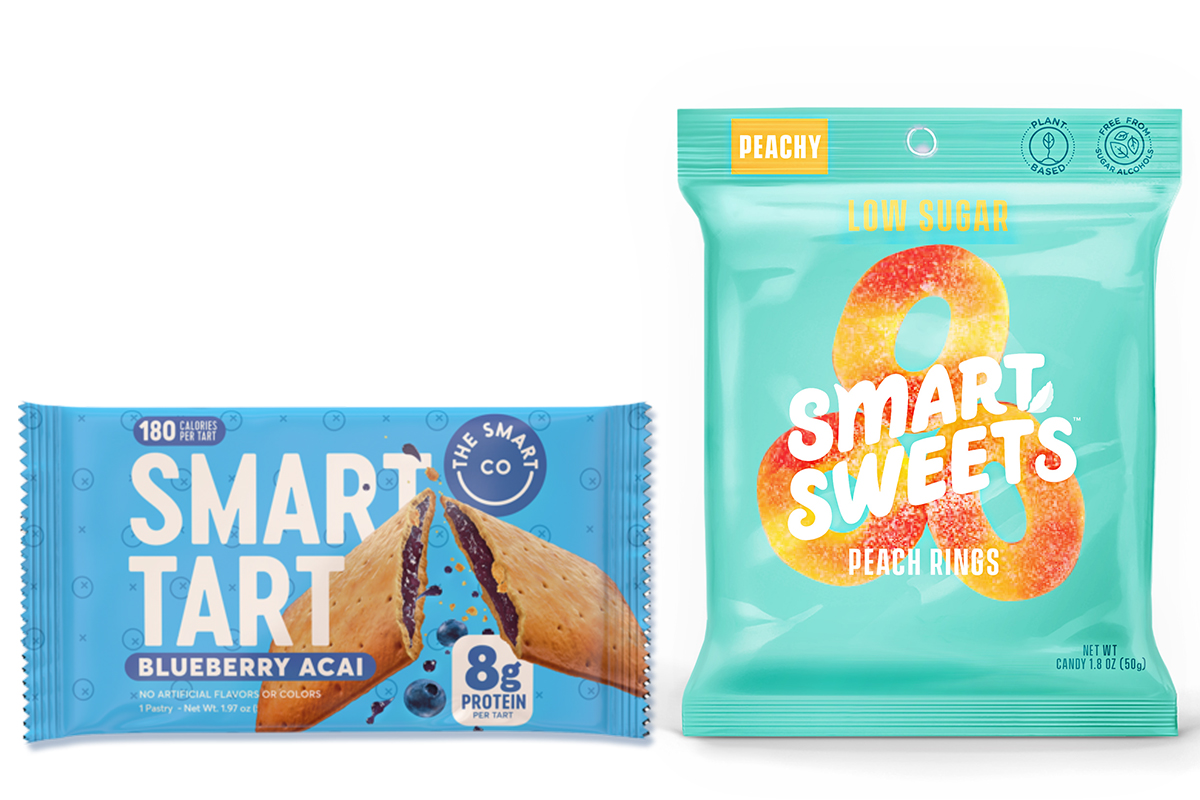
Smart is the new skinny
As consumers shift away from a traditional diet mindset in pursuit of holistic wellness, brands previously marketed as “thin,” “lean” or “skinny” are embracing new descriptors, such as “smart.”
Debuting at Sweets & Snacks is Smart Tart, a better-for-you take on the toaster pastry. Smart Food Co. L.L.C., Costa Mesa, Calif., offers a range of flavors, including blueberry acai, strawberry chia and cinnamon, with 8 grams of protein, 180 calories and 50% less sugar than the average brand, according to the company.
SmartSweets, Vancouver, B.C., is expanding its portfolio of reduced-calorie candies with Peach Rings gummies. Sweetened with stevia, the product has 85% less sugar than traditional candy with no artificial ingredients. Like all other SmartSweets products, which include gummy bears, sour gummies and sweet fish gummies, each serving has 3 grams of sugar and 80 calories.
Susie’s Smart Cookie, Katonah, N.Y., produces breakfast cookies and bites containing omega-3 fatty acids from canola oil, walnuts and ground flax, with oats, dried fruit and eggs.

Beverage flavors are bubbling up
Cocktails, coffee and cola are trending tastes in confections and snacks launching this year.
“We’re seeing a lot of products that are incorporating different drink flavors,” Ms. Schildhaus said.
Soda stars in several new candies. American Licorice Co., La Porte, Ind., is debuting Sour Punch Bites featuring cherry, lime and cola flavors that may be mixed and matched to create new combinations. The company also is introducing Red Vines root beer and orange cream licorice bites. Orange soda flavor is featured in new Sour Patch Kids and Swedish Fish chewy candies debuting from Mondelez International, Inc., Deerfield, Ill.
Other innovations at the show offer new ways to consume coffee. From the creator of Dippin’ Dots, 40 Below Joe, Carbondale, Ill., features frozen beads of coffee and dairy-free creamer in a range of flavors, including french vanilla, hazelnut, salted caramel, mocha and house blend. Tierra Nueva Fine Cocoa, Miami, is debuting Nudge Coffee Butter, a spread made entirely from Italian roast coffee beans.
Tea flavors are brewing in such products as layered matcha cream wafer cookies and a chai chocolate bar.
From Kopper’s Chocolate, Jersey City, N.J., On the Rocks Chocolate cordials contain a liquid center inspired by libations such as vodka and tequila. Wrapped in dark chocolate, the alcohol-free bites are available in Moscow mule, cold-brew coffee, barrel-aged bourbon and strawberry margarita varieties.
Brewhouse Legends from Mount Franklin Foods, L.L.C., El Paso, Texas, is a range of snack nut mixes inspired by craft beer and flavored with hops. Unique Pretzel Bakery, Inc., Reading, Pa., offers Original Sourdough Craft Beer Pretzel Rings made with malted barley and hops.

Next-generation jerky
The meat snack category is expanding with new formats and flavors as brands aim to remain competitive in the crowded marketplace.
Biltong is booming. The air-dried, South African-style meat snack appeals to consumer desire for convenient, high-protein, low- or no-sugar foods. Several exhibitors, including Stryve Foods, Plano, Texas; Ayoba-Yo, Springfield, Va.; and Kalahari Biltong, Cambridge, Mass., focus exclusively on biltong production, while others are adding it to their product lines. Chef’s Cut Real Jerky, Naples, Fla., is introducing biltong in original and spicy chili flavors, with 26 grams of protein and zero sugar.
Meat snack companies also may differentiate with texture. DE.HI Foods, Honolulu, offers crispy beef and pork jerky that “eats like a chip,” according to the company. Land O’Frost, Munster, Ind., recently introduced Gone Rogue, a crispy snack made from chicken that has been smoked, sliced, baked and seasoned.
Yet another take on the premium jerky trend are new vegan varieties made from ingredients such as mushrooms or fruit. Upton’s Naturals, Chicago, is introducing Jerky Bites made with wheat seitan in several flavors, including tamarind pepperoni, pineapple pink peppercorn and tarragon ginger lime. Each serving provides 8 to 10 grams of protein and 90 to 100 calories with a texture and chew similar to that of traditional beef jerky, according to the company.

Making keto convenient
Food manufacturers are launching convenient food and beverage products positioned around the popular ketogenic lifestyle. At Sweets & Snacks, exhibitors offering nutrition bars formulated for the high-fat, low-carb diet include Kiss My Keto, Los Angeles; Dang Foods, Berkeley, Calif.; Riverside Natural Foods, Vaughan, Ont.; and Love Good Fats, Toronto.
Such products are loaded with oils, nuts and seeds to help consumers achieve ketosis, a metabolic state linked with weight loss and performance benefits. Low-calorie sweeteners such as erythritol, stevia and monk fruit are key to keeping sugar low.
Fat Snax, Brooklyn, N.Y., makes low-carb, sugar-free cookies in flavors such as double chocolate chip, peanut butter, chocolate chip and lemon.
HighKey Snacks from Summit Naturals Inc., Blaine, Wash., is a brand of savory and sweet snacks marketed as low-carb and keto-friendly. Products include crunchy cheese bites made with cheddar and egg whites, bite-size cookies and nut butter made with macadamia nuts, pecans, hazelnuts, chia and pumpkin seeds.
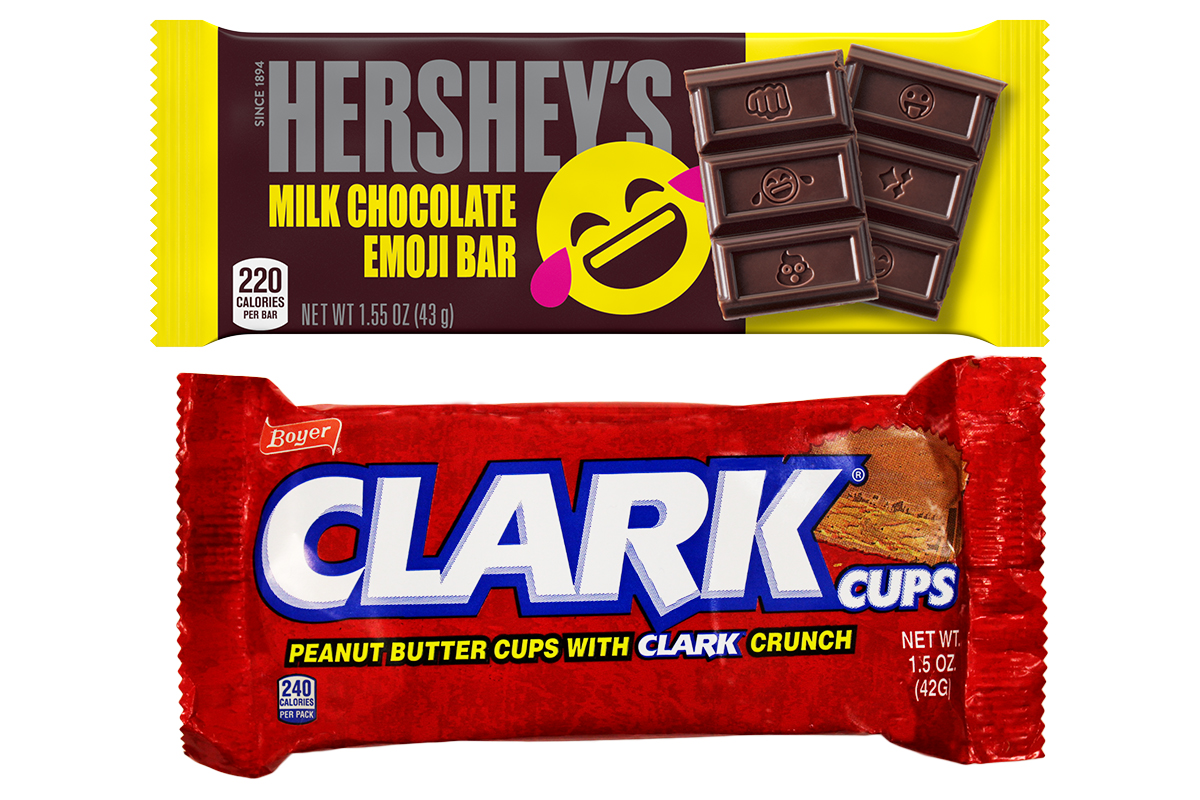
Classics, reinvented
Longstanding brands are introducing new formulations and forms to remain relevant to today’s consumer.
“We’re seeing what we’re calling ‘new takes on classics’… whether that’s a line extension… and also reimagining some old favorites,” Ms. Schildhaus said.
Boyer Candy Co., Altoona, Pa., the maker of Clark Bar, is launching Clark Cups, which are peanut butter cups incorporating the century-old chocolate bar brand’s signature crunch.
Boyer, which produces the Mallo Cup, bought the rights, recipes and equipment for the Clark Bar brand in 2018 after its previous owner, The New England Confectionery Co., filed for bankruptcy.
“It is very gratifying to bring the Clark name back to its home state of Pennsylvania, along with giving the classic candy a new twist,” said Anthony Forgione, president and chief executive officer of Boyer.
The Chick-O-Stick from Atkinson Candy Co., Lufkin, Texas, features an updated recipe with simple ingredients and more peanut butter. The product, characterized by its flaky, crunchy combination of peanut butter and toasted coconut, originated in the 1940s. Atkinson said it has removed artificial red and blue coloring in favor of colors derived from turmeric and vegetable juice concentrate.
The Hershey Co., Hershey, Pa., is debuting a new design for its namesake milk chocolate bar for the first time in its 125 years with the launch of its limited-edition Hershey’s Milk Chocolate Emoji bar.
“Our classic Hershey’s bars were made to be shared with others,” said Kriston Ohm, senior manager, Hershey’s brand. “By adding an emoji design to each pip of chocolate, we hope that parents and kids are inspired to share a chocolate emoji and make a connection with someone new.”
Impossible Foods raises $300 million in latest funding round

REDWOOD CITY, CALIF. — Impossible Foods, the maker of the plant-based Impossible Burger, has raised another $300 million in a Series E funding round led by existing investors Temasek and Horizons Ventures. To date, the company has raised more than $750 million since launching in 2011.
Impossible Foods said it will use the proceeds from this latest equity funding round to add a third shift of workers and second production line at its manufacturing plant in Oakland, Calif., with additional expansion announcements coming later this year. The company said it will hire at least 50 new employees at the plant, which currently employs 70 full-time workers.
“We have cracked the molecular code for meat and built an industry-leading intellectual property portfolio and brand,” said David Lee, chief financial officer for Impossible Foods. “Our global financial partners are supporting a technology powerhouse that will transform the global food system.”
The company said it is experiencing unprecedented demand for the Impossible Burger, which began appearing on restaurant menus across the country in 2016. In January, Impossible Foods debuted an upgraded recipe that is made with soy protein instead of wheat protein and may be steamed, seared or flame-grilled. The product is now sold in more than 7,000 restaurants in North America and Asia. Recently, Red Robin added the Impossible Burger to its menu at nearly 500 restaurants nationwide, and Burger King began testing its Impossible Whopper in the St. Louis area with plans to serve the item at all 7,200 U.S. restaurants by the end of the year.
The Impossible Burger is slated to launch in retail outlets later this year.
The latest fundraising round for Impossible Foods marks the largest ever for a plant-based meat company and follows a successful initial public offering by competitor Beyond Meat, El Segundo, Calif., said Bruce Friedrich, executive director of The Good Food Institute, Washington.
“The success of Impossible Foods and Beyond Meat is proof that plant-based meat has arrived,” Mr. Friedrich said. “With these two companies now valued in the billions of dollars, it’s clear that the plant-based meat market is both hot and here to stay.”
Plant-based meat, egg and dairy companies in the United States have raised more than $16 billion in the past decade, including $13 billion in 2017 and 2018, according to research from The Good Food Institute.
“Impossible and Beyond both have a vision of a meat market that puts healthier and more sustainable products in front of consumers,” Mr. Friedrich said. “Because plant-based meat is so much more efficient, the products will be less expensive at scale. That represents a truly massive consumer market — literally, everyone who eats — and so also represents a massive investment opportunity.”
ART
Court Denies Italy’s Request for Return of Disputed da Vinci Work
Content Courtesy of: nytimes.com
Written by: Catherine Hickley
The Swiss court ruled that it was not bound by the Italian law that held the portrait had been exported illegally.

Italy had sought the return of this Renaissance portrait of a noblewoman, arguing it had been illegally exported. CreditCreditCantonal Police of the Canton Ticino
Switzerland has denied a request from the Italian government to hand over an Italian Renaissance portrait that was once attributed to Leonardo da Vinci and offered for sale for more than $100 million.
Swiss police impounded the painting, “Portrait of Isabella d’Este,” in a bank vault in Lugano in 2015, at the urging of the Italian government, which said its Italian owner had failed to acquire the necessary export license to take the painting out of Italy.
Italy’s strict laws set forfeiture as the penalty for illegal export of cultural heritage.
But the Swiss Supreme Court said on Wednesday that the conditions for a handover are not met, overturning a ruling last year by the country’s federal criminal court. The criminal court had called for the painting to be transferred to Italy on the basis of mutual assistance in criminal matters.
The Supreme Court said a request based on international mutual criminal assistance conventions should only be met in the case of activity that is also criminal in the country receiving the request.
“The export of private cultural property out of Switzerland to Italy is not a criminal action under Swiss law,” said Marc Weber, the lawyer for the painting’s owner, Emidia Cecchini.
In 2017, Ms. Cecchini was found guilty by an Italian court of transferring abroad an item of cultural interest without an export license. She served a period of community service as her penalty, her lawyer said.
She has argued that the painting has been the property of her family for more than a century and was kept in Switzerland for decades. She said she only took it to Italy briefly in 2010.
The Italian authorities had brought charges after the discovery in 2013 that the painting, which a scholar had attributed to Leonardo, was being offered for sale and that it had been in Italy three years earlier.
Laboratory tests have dated the painting to between 1460 and 1650. Carlo Pedretti, a former professor emeritus of Italian Art History at the University of California, Los Angeles, who died last year, first identified it as a Leonardo but later denied the attribution.
Other scholars have dismissed any attribution to Leonardo.
Isabella d’Este was the Marchioness of Mantua and an important patron of the arts in Renaissance Italy. Reuters reported that Italy’s Justice Ministry declined to comment on the Swiss ruling.
Lutz Bacher, Conceptual Artist Who Hid Much About Herself, Dies at 75
Content Courtesy of: nytimes.com
Written by: Holland Cotter

Lutz Bacher, an American Conceptual artist who, early in her career, adopted that fictional, masculine-sounding name, and who thereafter refused to reveal personal details about her life, died on May 14 in Manhattan. She was 75.
Galerie Buchholz, which represents her work in Germany, said the cause was a heart attack.
Ms. Bacher gave out a variety of birth dates over the years (the real one was Sept. 21, 1943), but she did not say where she was born or provide any information about her family or educational background. All that was generally known was that she began making art in the San Francisco Bay Area in the 1970s, when Conceptualism had succeeded Minimalism as the influential new art movement.
One of its champions, the art historian Lucy Lippard, defined Conceptualism as art “in which the idea is paramount and the material form is secondary, lightweight, ephemeral, cheap, unpretentious and/or ‘dematerialized.’ ” Ms. Bacher’s work fit this model, and added to it distinctive degrees of political commentary and personal emotion.
She worked primarily with everyday found materials — objects (snapshots, baseballs), words (interviews, men’s-room graffiti), sounds (film clips, rock songs) — from which she drew resonance by editing them, combining them or uncovering half-hidden details.

“Yamaha, 2010,” an installation by Ms. Bacher, featuring an electronic organ, tin pipes, paint, bamboo and wires.
Credit by: Galerie Buchholz
An early work, “Men at War,” from 1975, consisted of a series of photographs, derived from a single found negative, of American sailors relaxing together on a beach in Vietnam. What’s striking at first is the convivial, mildly eroticized mood of the gathering. But when, in a close-up, you catch sight of a swastika drawn on one man’s chest, a homosocial idyll becomes an image of incipient male violence.
Much of her work points to the arbitrary nature of historical “truth.” For a 1976 installation called “The Lee Harvey Oswald Interview,” she created a set of nine increasingly fractured collages by splicing together photographs of Oswald and her own musings, handwritten and typed, about conspiracy theories related to Oswald and the assassination of President John F. Kennedy. (The work is in the collection of the Metropolitan Museum of Art and was exhibited there last year.)
Beginning in the 1990s, for a kind of video self-portrait, Ms. Bacher asked several people, including family members and artists (some of whom she barely knew), to sit in front of a camera and talk about her as she listened out of sight and pitched questions.
The tapes go on for hours (she published the transcripts as a book) and, in the end, leave only a diffuse and contradictory sense of who she is as a personality and an artist. They suggest that her insistent anonymity — fake name, concealed life — was part of a careerlong strategy to present herself as a Conceptual work.
This not to say that her art felt remote or hermetic. It was notable for its humor, but also for its emotional intimacy. When her charismatic New York art dealer Pat Hearn learned she had liver cancer in the 1990s, Ms. Bacher set up a stationary camera to film her working in her gallery office. When Ms. Hearn died in 2000 at 45, Ms. Bacher edited down hundreds of hours of tape to create a moving 40-minute memorial to her friend.

Ms. Bacher made this image of herself lying on a beach her official portrait, and allowed it to be circulated.
Credit by: Galerie Buchholz
And her contribution to the 2012 Whitney Biennial was memorably poetic. It was conceived in several evocative but enigmatic units.
One, called “The Celestial Handbook,” comprised 84 framed book pages illustrating galaxies, nebulae, comets and other astronomical formations. There was a sculptural piece in the form of a church organ.
And there was a gallery installation consisting of hundreds of old baseballs strewn across the floor and a video, imageless but with a dialogue clip from the 1988 film “The Unbearable Lightness of Being” as a soundtrack.
In the clip, two lovers speak. A woman asks, “What are you thinking?”; the man answers, “I’m thinking how happy I am.” Some people read the work as a tribute to Ms. Bacher’s husband, Donald C. Backer, an astrophysicist and professor at the University of California, Berkeley, who had died of a heart attack two years earlier. They had been married almost 40 years.
Ms. Bacher is survived by her son, David A. Backer; a granddaughter, Annika Backer; a sister, Jo-Anna Lutz Jones; and a brother, Patrick B. Lutz.

A self-portrait of Ms. Bacher from 2017 showing her reflection in a “surveillance bubble.” It was one element of an artwork titled “Cyclops,” in which she also installed a number of mirrored plastic half-globes that were intended to conceal surveillance cameras.
Credit by: Galerie Buchholz
In 2009, Ms. Bacher had a retrospective, titled “My Secret Life” and organized by Lia Gangitano, at PS1 Contemporary Art Center (now MoMA PS1) in Queens. A two-venue solo show at New York University in 2018 found her working again in a barbed topical mode. At the university’s 80WSE gallery, a display, without commentary, of 100 mass-produced Chinese postcard images of Mao Zedong constituted a study in how a monstrous leader could, by achieving the status of folk hero, become unassailably powerful.
A simultaneous exhibition, called “Open the Kimono” and installed in an N.Y.U. lecture hall, was a slide show of phrases that Ms. Bacher had jotted down from television commercials, radio talk shows and overheard conversations.
Some of the phrases (“I believe in love”) were bland-inane; others (“Face-lift in minutes at home”) were pop-weird; still others (“We are in a post-truth environment”) were direct references to current politics. Together, they added up to the equivalent of handwritten tweets, a random harvest of outtakes from American culture in the present.
In 2013, Ms. Bacher moved from Berkeley to New York City, where she is represented by Greene Naftali Gallery. She appeared in three Whitney Biennials (1991, 2000 and 2012), and in the last decade of her career showed in museums internationally, including the Kunstverein Munich; Portikus in Frankfurt; Secession in Vienna; the Kunsthalle Zurich; and the Institute of Contemporary Arts in London.
In 2018, she produced a book version of “Open the Kimono.” An earlier book appeared at the time of her 2009 PS1 retrospective. Titled “Smoke (Gets in Your Eyes),” the book references past work (the Vietnam photographs, the “Do You Love Me?” interviews), but is a nonchronological, nonthematic jumble, interspersed with pornography magazine clips, advertisements, and personal notes. It documents an art that avoids a signature style and an artist who refused a categorical identity.
In an interview, Ms. Bacher once referred to her work as “one big ruin.” It was a ruin she built through a lifetime of self-invention through art.
FASHION
Virgil Abloh Has Designs on High Culture
Content Courtesy of: nytimes.com
Written by: Dan Hyman
CHICAGO — One morning last month, still reeling from a weekend stuffed with international traveling on a private jet and a D.J. gig at Coachella, the fashion designer Virgil Abloh strode into the whirring basement workshop here at the Museum of Contemporary Art (MCA). A team of collaborators quickly surrounded him on all sides, each with a notebook or laptop, as he investigated a metallic clothing rack with equal-parts curiosity and skepticism.
“I’d say this is a good start,” Mr. Abloh, the artistic director of men’s wear for Louis Vuitton and creator of the popular streetwear label Off-White, said while surveying the custom-numbered and monogrammed prototype. It was an object he had workshopped with the museum group over months: Eight racks would display clothing he’d designed over his career, and thread together the narrative for “Virgil Abloh: Figures of Speech,” the 38-year-old designer’s retrospective, which opens on June 10. Long believing his talent lies not in creating something wildly original but in altering an existing item by roughly 3 percent to make it new, Mr. Abloh felt the clothing rack needed his personal touch.
“It’s adjusting the world to leave my signature, and it has to be exact,” he’ll tell me later, explaining his precise design strategy. For now, he’s spotted an item to complete the rack: a canary-yellow safety manual encased in a matching metal cage. Stripping it from the wall, Mr. Abloh — a trained architect, graphic designer and artisan — held the cage up to the rack and rubbed his faint beard as he assessed its worth for inclusion.
After a brief silence, Mr. Abloh nodded his head in apparent satisfaction. For the exhibition, the manual would register clothing on display: when it was made, its inspiration and context. “In that way it becomes like an archive,” he told the assembled group, which included several museum employees as well as the fabricator. “It’s not, like, something you’ll actually use. It’s just so you feel like there’s a record of everything on there.” Custom-designed clothing racks by Rob Tivadar. Racks will display about 70 designs from Virgil Abloh’s collections over a decade, including Been Trill, Pyrex, Off-White and Louis Vuitton.
Credit by: David Kasnic for The New York Times
Custom-designed clothing racks by Rob Tivadar. Racks will display about 70 designs from Virgil Abloh’s collections over a decade, including Been Trill, Pyrex, Off-White and Louis Vuitton.
Credit by: David Kasnic for The New York Times
 Mr. Abloh’s finishing touch on the cart was a yellow safety cage, which will hold details of each piece of clothing.
Credit by: David Kasnic for The New York Times
Mr. Abloh’s finishing touch on the cart was a yellow safety cage, which will hold details of each piece of clothing.
Credit by: David Kasnic for The New York Times
Lately, as he’s prepared for his exhibition, Mr. Abloh has been fixated not only on documenting his life and career but also assessing where, if at all, a self-described “nontraditional” artist like himself fits into the modern art-museum landscape. His Milan-based Off-White fashion label, during the fourth quarter of 2018, trailed only Gucci as the “hottest” fashion brand, according to the Lyst Index, which converts sales and “sentiment analysis” into rankings, but he still considers himself an art-world outsider.
He never expected the art world to validate his practice, and in many ways he still feels museums remain noninclusive and even hostile territory for new-age creators like himself, the sort who wear baby-blue screen-printed hoodies and orange Nike Dunks to meetings instead of black turtlenecks and small round glasses. And yet, Mr. Abloh will tell you, he’s long been concerned with legacy. Museums, for all his issues with whom they choose to exalt, still exist in his mind as “the vault to record what’s happened and to represent it for a lifetime.”
“I hope this work is revered and remembered,” Mr. Abloh recalled thinking back during his teenage years, when he first began maintaining the meticulous archive of his creations that he and Michael Darling, his MCA curator, have scoured for this exhibition. It’s a diverse and dense multidisciplinary collection that encompasses more than 15 years in the fields of fashion, music and all matters of design. Mr. Abloh said he senses that some in the art world might know him only from his recent work with Louis Vuitton but, specifically intent on showcasing an artistic throughline to his content — namely the dissonance between what an item is traditionally labeled and the infinite possibilities of what it could be — Mr. Abloh was intent on stuffing as much as possible into this show.


“I need this to jell together the kid that knows every Tumblr post that I ever made to someone who doesn’t even know of Off-White but just knows my name keeps popping up,” Mr. Abloh said. He will repeatedly tell you that there’s an “air of impossibility” to his journey from Rockford, Ill., skate punk to architecture student; from fashion-world self-starter and associate of the rapper Kanye West to the first African-American man appointed to head a French luxury fashion house.
Like its creator, the show is varied in its artistic disciplines: There’s jewelry and chairs and luggage and dresses and turntables and a five-foot plexiglass recreation of the rapper’s 2013 “Yeezus” album cover that Mr. Abloh designed while serving as Mr. West’s creative director. If it’s all a bit overwhelming, well, there’s a low-set skateboarding ramp in the galleries that doubles as a bench.

Mr. Abloh designed the album art for “Yeezus” by Kanye West, released in 2013.
Over the past three years, as Mr. Abloh prepared for the exhibition, he’s come to see his formal recognition by a museum as a positive moment, not just for a self-described “commercial designer” who has collaborated with Ikea and Evian water, but for art museums on the whole — a mark of their cultural progress.
“It’s a sign that the system was out of date,” Mr. Abloh said one evening at Soho House Chicago, the members’ club. His archetypical fan and buyer is often derided as a “hypebeast,” a stereotype of a street-wear-obsessed millennial male with disposable income. Mr. Abloh views this person not as a burden on his artistic credibility but rather an opportunity: If they visit the MCA for the first time to view his exhibition, that’s a win for his generation. “It shows that the kids knew better than the establishment,” he said.
For the exhibition’s duration, a black flag emblazoned with the words “Question Everything?” will stand in the plaza. A working definition of “streetwear” prominently features in the opening section of gallery and together they drive home Mr. Abloh’s belief that his exhibition is itself a form of infiltration. For too long, he added, “there was this lost connection between the museum as a cultural institution supposedly representing what’s happening now versus presenting retrospectives of things that have been celebrated a million times over.”

A blueprint for the exterior of the Museum of Contemporary Art Chicago as it will appear during the exhibition, showing Mr. Abloh’s "Question Everything Flag, 2018."
Credit by: David Kasnic for The New York Times
The section of the exhibition Mr. Abloh is most excited about is entitled “The Black Gaze.” It showcases his works that, while never explicitly described as such, he now says center on race: billowy black ballerina-inspired dresses he made with Nike for the tennis star Serena Williams as part of his “Queen” collection; Louis Vuitton campaign photographs featuring African children; a neon sign from a 2016 Off-White runway show reading “You’re obviously in the wrong place.”(It’s a line Beverly Hills’ saleswomen used when Julia Roberts enters their store, in her stripper boots, in “Pretty Woman.”)
Samir Bantal, director of AMO, a research studio set up by the architect Rem Koolhaas, has been helping Mr. Abloh design the exhibition and suggested this section. “I thought it would be interesting to show this political side of him a bit more boldly than having it be more subconscious or hidden,” Mr. Bantal said.
When Mr. Darling reached out to Mr. Abloh in 2016 with the idea for an exhibition, the designer’s name was foreign to many outside fashion circles. “And so it really took us a while to get other museums on board to take the show,” Mr. Darling recalled. (“Figures of Speech” will travel later this year to the High Museum of Art in Atlanta, the ICA Bostonand Brooklyn Museum in 2020).
Mr. Darling’s sweet spot is exhibiting artists who are, he says, “a bit misunderstood,” including the Japanese artist Takashi Murakami, who showed at the MCA in 2017. He recalls how some art critics griped when the MCA brought the exhibition, “David Bowie Is,” from the Victoria & Albert Museum in 2015. Mr. Darling said he expects similar pushback from “art snobs” to Mr. Abloh’s exhibition.
“There are going to be people that turn up their noses at it,” the curator said. “But that’s an exciting thing for me: to prove them wrong and show them how serious and how worthy he is of this.”
Mr. Darling referred to Mr. Abloh as an eager, hands-on student. Those who’ve collaborated with Mr. Abloh are aware that he’s sometimes leaning on them but they hardly mind.


“Virgil is the type of creator who would devour everything around him and turn it into his nourishment,” Mr. Murakami wrote in an email. He first met Mr. Abloh when the Japanese artist designed Mr. West’s 2007 album “Graduation,” and collaborated with the designer for last year’s joint exhibition, “America Too,” at Gagosian’s Beverly Hills gallery.
Jarrett Reynolds, the senior design director at Nike, who has worked with Mr. Abloh for four years, said that there’s a transactional quality to the teamwork. “We know our strong point is utility and performance whereas Virgil’s superpower is his connection to culture, insight, aesthetic,” Mr. Reynolds said.
Bess Williamson, a professor of art history, theory and criticism at the School of the Art Institute of Chicago, said Mr. Abloh’s showing at the MCA is not so much a risk as an evenhanded credibility exchange between artist and venue.
“I would fit this into the idea of co-branding,” she offered. Mr. Abloh receives the art world’s stamp of approval; the MCA gets a “cool” bump. Of course, there’s also much money to be made: a custom Virgil Abloh store with exclusive merchandise will live in the MCA over the course of the exhibit. And a pop-up Nike store curated and designed by Mr. Abloh is set to open on nearby Michigan Avenue.
Ms. Williamson noted the inherent paradox of a museum showcasing a designer affiliated with a luxury brand like Louis Vuitton. “There’s a sense of democratizing the museum by having popular work — fashion, music, things that are more inviting and less intimidating for a broader audience — but at the same time it’s the most elite version of that,” she said.
One morning last month, perched on a park bench near the museum, and steps from his idling Mercedes G-Wagon, Mr. Abloh admitted that he’s been reassessing where his narrative intersects with that of contemporary art.
“For so long I didn’t see artists or designers that looked like me in spheres of high art or high fashion so I believed I couldn’t do that,” he said. “But now, in this moment, in a way, I’ve become part of the establishment.”

Mr. Abloh, whose work has been primarily recognized in fashion spaces rather than art, trained as an architect. “Now, in this moment, in a way, I’ve become part of the establishment,” he admits.
Credit by: David Kasnic
ADVERTISING
Ikea Turned the Living Rooms From Simpsons, Stranger Things and Friends Into Perfect Ads
Content Courtesy of: adweek.com
Written by: David Griner

Ikea never mentions The Simpsons by name, but it's easy to recognize the cartoon's iconic living room.
You definitely know the rooms, but how well do you know the furnishings?

 “The Ikea team worked closely with the creatives for months. They went through hundreds of items to find the perfect pieces that would bring those iconic rooms,” says Vinod Jayan, managing director for IKEA in the UAE, Qatar, Egypt and Oman. “It was a great collaborative effort that led up to a stunning result. A true testament of what IKEA represents: a place where everyone can bring whatever idea they see or have to life.”
On a microsite for the campaign, you can see each room and learn more about the furnishings featured in the ads.
“The Ikea team worked closely with the creatives for months. They went through hundreds of items to find the perfect pieces that would bring those iconic rooms,” says Vinod Jayan, managing director for IKEA in the UAE, Qatar, Egypt and Oman. “It was a great collaborative effort that led up to a stunning result. A true testament of what IKEA represents: a place where everyone can bring whatever idea they see or have to life.”
On a microsite for the campaign, you can see each room and learn more about the furnishings featured in the ads.


In addition to appearing in ads and some editions of the Ikea catalog, the campaign will also make a real-world appearance, with the rooms being brought to life at some Ikea stores in the Middle East.


CREDITS:
Agency: Publicis Spain
Chief Creative Officer: Eduardo Marques
Creative Director: Juliana Paracencio
Creative Director: Luiz Vicente Simões
Art Director: Diego Fernández-cid
Copywriter: Guillermo Laureano Ley Núñez
3-D Artist/Illustrator: Bruno Rodrigo de Miranda
Client: IKEA, UAE
IKEA Regional GM Marketing, Com., Interior Design, Consumer engagement: Carla Klumpenaar
IKEA Regional Marketing Com. Manager: Amer Yaghi
UBER LAUNCHES SUBMARINE RIDES TO GREAT BARRIER REEF
Content Courtesy of: adage.com
It’s a new feature called ScUber—and you only need $2,000

The submarine service is designed to support the protection of the coral reef system through Uber’s new partnership with the organization Citizens of the Great Barrier Reef.

Credit by: Tourism and Events Queensland
Uber is no stranger to nontraditional marketing stunts, having previously ventured into ice cream delivery and a service called UberKittens, which allowed customers to request a playdate with kittens to support the Pennsylvania Society for the Prevention of Cruelty to Animals. The company is also working to develop a flying taxi via a partnership with Aurora Flight Sciences.
The submarine offering comes after Uber’s initial public offering flop on May 11; shares plunged immediately after trading opened and fell as much as 8.8% from its IPO price of $45 per share by the end of its first day. The stock price is down about 10% from the IPO figure amid flareups in U.S.-China trade negotiations and the recent dismal performance of rival Lyft Inc.
THE NORTH FACE APOLOGIZES FOR ITS WIKIPEDIA HACK
Content Courtesy of: adage.com
Written by: Adrianne Pasquarelli
The stunt was part of a campaign from the sportswear brand’s Brazil office

But Wikipedia editors and some consumers were outraged at the stunt, which Wikipedia says breaches “the Terms of User for undisclosed paid advocacy.” The North Face issued an apology via Twitter.
Editors of the Wikipedia platform removed the photos, resulting in the North Face’s apology soon after. A spokeswoman for The North Face reiterated the apology and commitment to better Wikipedia training moving forward.
TECH
The First Public Schools In The US Will Start Using Facial Recognition Next Week
Content Courtesy of: buzzfeednews.com
Written by: Davey Alba

Next week, a school district in western New York will become the first in the United States to pilot a facial recognition system on its students and faculty. On Monday, June 3, the Lockport City School District will light up its Aegis system as part of a pilot project that will make it broadly operational by Sept. 1, 2019. The district has eight schools.
Superintendent Michelle Bradley announced the move on Tuesday, as first reported by The Lockport Union-Sun and Journal. Bradley described the test as an “initial implementation phase" meant to troubleshoot the system, train district officials on its use, and discuss proper procedures with local law enforcement in the event of an alert triggered by the facial recognition tech.
The Lockport pilot comes amid increased scrutiny of facial recognition’s efficacy across the US, including growing civil rights concerns and worries that the tech may serve to further entrench societal biases. Earlier this month, San Francisco banned police from using facial recognition, and similar bills in the US hope to do the same. Amazon has endured persistent pressure — including from its own shareholders — for its aggressive salesmanship of its facial Rekognition system to law enforcement agencies. Rep. Alexandria Ocasio-Cortez expressed concern that facial recognition could be used as a form of social control in a congressional hearing on the technology last week.
At the same time, reports and studies of facial recognition’s inaccuracies and mistakes — especially on women and people of color — continue to emerge.
Other schools have considered implementing facial recognition systems, but Lockport will be the first public school district to begin using the tech, the American Civil Liberties Union told BuzzFeed News.
BuzzFeed News has reached out to the Lockport City School District and the maker of the Aegis system for comment.
Lockport resident Jim Shultz, a vocal critic of the school district’s plan to use facial recognition, described the upcoming pilot as “a dicey move”: “I think the district is desperate not to begin another school year with their expensive system just sitting there,” he told BuzzFeed News.
In March 2018, Lockport announced its plans to install a facial recognition security system, which it funded through the New York Smart Schools Bond Act — an act meant to help state schools augment their instructional tech. But instead of buying laptops and iPads, Lockport submitted a proposal for a high-tech security system, and allocated much of the $4.2 million it was given toward adding dozens of surveillance cameras in the school and installing the facial recognition system Aegis, which is provided by Canada-based SN Technologies. To date, Lockport has spent $1.4 million to get the system up and running.
“Aegis is an early warning system that informs staff of threats including guns or individuals who have been identified as not allowed in our buildings,” stated an FAQ distributed to the school’s parents and obtained by BuzzFeed News. “Aegis has the ability [to screen] every door and throughout buildings to identify people or guns. Early detection of a threat to our schools allows for a quicker and more effective response.”
“San Francisco banned this tech, and it’s this major city closest to all the people who understand this tech the best. Why in the world would we want this to come to New York, and in a place where there are children?”
The district's letter to parents makes the case for facial recognition in light of the specter of recurring school shootings. "Much to our dismay, acts of violence in schools continue to occur in our country," it reads. "Please be assured that the Lockport City School District continues to make school security a priority."
According to the FAQ, Aegis will track individuals who are “level 2 or 3 sex offenders, students who have been suspended from school, staff who have been suspended and/or are on administrative leave, any persons that have been notified that they may not be present on District property, anyone prohibited from entry to District property by court order … or anyone believed to pose a threat based on credible information presented to the District.” The Lockport Journal further reported that the object recognition system will also be able to detect 10 types of guns.
The video footage will be kept for 60 days, after which it will be erased from the server, the FAQ says. And while it adds that the system “will not generate information on or record the movements of any other district students, staff or visitors,” previous reporting from BuzzFeed News has shown that in order to effectively flag the faces of "persons of interest," facial recognition systems must also disregard the faces of persons who are not of interest. In other words, it analyzes them, too.
After Lockport’s initial announcement, the New York Civil Liberties Union investigated the effort and wrote letters to the New York State Education Department, asking it to intervene and block the project. “This is opening the floodgates,“ Stefanie Coyle, education counsel for NYCLU, told BuzzFeed News in an interview. “San Francisco banned this tech, and it’s this major city closest to all the people who understand this tech the best. Why in the world would we want this to come to New York, and in a place where there are children?”
Meanwhile, New York State Assembly Member Monica Wallace has introduced a bill that, if passed, would force Lockport to stop the use of facial recognition for a year while the State Education Department further studied the tech.
But the NYCLU’s Coyle also pointed out that the New York State Assembly’s legislative session is “almost over” — it comes to a close in June. “We’re running out of time for [this bill] to be passed this session. So if it doesn’t pass this session, there’s nothing that will stop Lockport from implementing this facial recognition system in the fall.”
UPDATE
On Thursday, the New York State Education Department told BuzzFeed News it has asked Lockport to delay its use of facial recognition technology on students.
In an emailed statement, a spokesperson said, “The Department is currently reviewing the Lockport CSD’s privacy assessment to ensure that student data will be protected with the addition of the new technology. The Department has not come to the conclusion that the District has demonstrated the necessary framework is in place to protect the privacy of data subjects and properly secure the data. As such, it is the Department’s continued recommendation that the District delay its use of facial recognition technology.
Regulations are in the process of being finalized that will adopt a standard for data privacy and security for all state educational agencies. We recommended in past communication that the District consider reviewing the standard and related materials in developing and refining its data security and privacy program. We will remain in contact with school district officials.”
As first reported by The Lockport Journal's Connor Hoffman, District Superintendent Michelle Bradley said she made the state education department aware of the district's intentions to activate its facial recognition system earlier this month, but no one from the department responded at the time — so Lockport assumed it could go ahead with its trial run of the technology.
CULTURE
A Video Game Went Viral Across India. Then Police Started Arresting Its Young Players.
Content Courtesy of: buzzfeednews.com
Written by: Pranav Dixit
Fears about PUBG’s violence and addictiveness led officials in the Indian state of Gujarat to ban the video game. But things didn’t stop there — soon young men were being arrested for gaming.
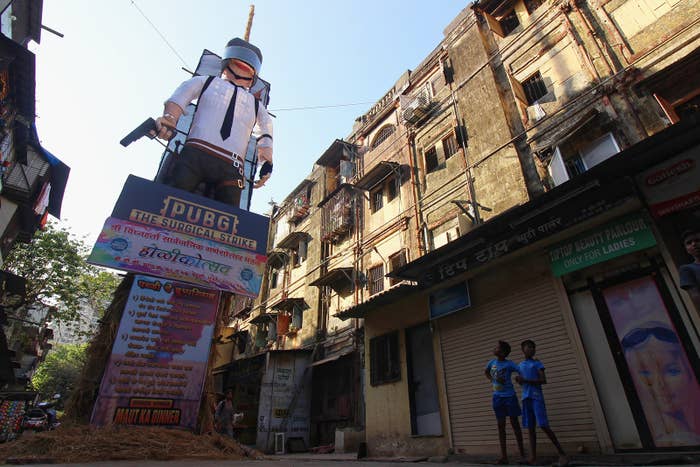
An effigy of a PUBG character is readied be set on fire as part of the Hindu festival of Holi in Mumbai on March 19. Representations of evil are burned on the holiday. The text on the board below warns people about PUBG’s addictive effects.
Credit by: Himanshu Bhatt
It was 10 p.m. on a sweltering March evening, and Siraj Ansari was perched on a makeshift stool outside Mayur Cafe, a small tea shop in Ahmedabad, a city in the western state of Gujarat in India. Ansari and three of his friends sat glued to their mobile screens along with half a dozen other neighborhood boys, cheap headphones plugged tightly into their ears, and oblivious to the world around them.
They didn’t hear the patrol van pulling up, didn’t hear the slam of car doors, didn’t hear the footsteps clicking toward them, didn’t hear and the boys around them scrambling off into the darkness. When Ansari looked up, a plainclothes police officer glowered at him, and motioned to him to stand up with his baton. Ansari unplugged his headphones slowly and rose, tapping his friends on the shoulders.
You were playing PUBG, the cop said. We saw you. We’ve been watching you.
PUBG, short for PlayerUnknown’s Battlegrounds, is a hugely popular, online multiplayer shooting game that’s been topping the charts in countries around the world, including India — but in the second week of March, authorities in multiple Gujarati cities, including Ahmedabad, had banned it, saying it was too addictive and violent. Ansari had heard about the ban in the news, but hadn’t taken it seriously. After all, it’s just a video game, he had thought. What could possibly happen?
Within minutes, the cops had snatched the four boys’ phones, bundled the boys into the van, and sped off to a police station just minutes away, while the boys sat in terrified silence in the back.
Gaming has only become part of India’s still-young digital culture in the last few years as millions of residents who just got their first smartphones suddenly found themselves swept up in phenomena like Candy Crush Saga and Pokémon Go. But nothing — nothing — has come close to becoming as viral as PUBG.
Within months of its launch, PUBG became the top-grossing app on Android in the country and vaulted overnight into the public consciousness. Its popularity has been unprecedented. There was a PUBG-themed wedding photoshoot; a teen racked up a $700 bill for in-app purchases on his dad’s credit card (that’s enough to pay several months of rent in a large Indian city). Even Bollywood jumped in, getting a popular actor to promote a military-themed movie by playing PUBG live in front of signage with the film’s release date.
But the backlash followed just as swiftly. In January, an activist based in Hyderabad demanded a national ban of the game, saying it promoted violence and cruelty. In February, an 11-year-old boy from Mumbai and his mother filed a court petition to get PUBG banned in schools because, she claimed, it promoted “violence, aggression, cyber bullying” and was addicting. And in March, India’s National Commission for the Protection of Child Rights sought a report from the country’s Information and Technology Ministry asking what action it was taking against the game.
No state went as far, however, as the western state of Gujarat. On March 6, police in the Gujarati city of Rajkot banned the game within its city limits.
“From the various sources, it comes to our knowledge that after playing games like [PUBG,] violent traits are shown to be increased in youth and children,” Rajkot Police Commissioner Manoj Agarwal wrote in an official notification. “Due to these games, the education of children and youth are being affected and it affects the behaviour, manners, speech and development of the youth and children.”
Anyone caught playing the game would be jailed and fined under Indian criminal laws, he added, urging people to call the nearest police station if they saw anyone playing it. Agarwal did not respond to BuzzFeed News’ requests for comment.
Playing a video game seemed like dubious grounds for arrest to PUBG fans and free internet advocates, but less than a week later, other parts of Gujarat, including Ahmedabad, the state’s largest city, and Vadodara, the third-largest city, had banned the game, citing similar reasons.
The national hysteria around PUBG is unfurling at a moment when Indians are struggling with fallout from rapid technological progress: the deadly spread of rumors on WhatsApp, rampant harassment on social media, and dangerous misinformation campaigns. People now demand that tech companies grapple with their effects on users — and yet the particular panic around PUBG and the resulting arrests in Gujarat reflect lawmakers’ blunt response when forces they see as destabilizing sweep in. Video game bans are not unfamiliar; but arresting young men for playing them, to safeguard “the education of children and youth,” is a severe and questionable method of protecting the interests of young adults.
Souvik Mukherjee, a professor at Kolkata’s Presidency University who has a PhD in computer games as storytelling media, said digital gaming used to be restricted to a young, urban population in India, “but now, with the huge surge towards mobile gaming, those boundaries have been crossed.” As gaming “is a growing phenomenon and is beginning to have a serious cultural impact” in India, it should be studied more closely “so that such uninformed reactions to games are no longer an issue,” he said.
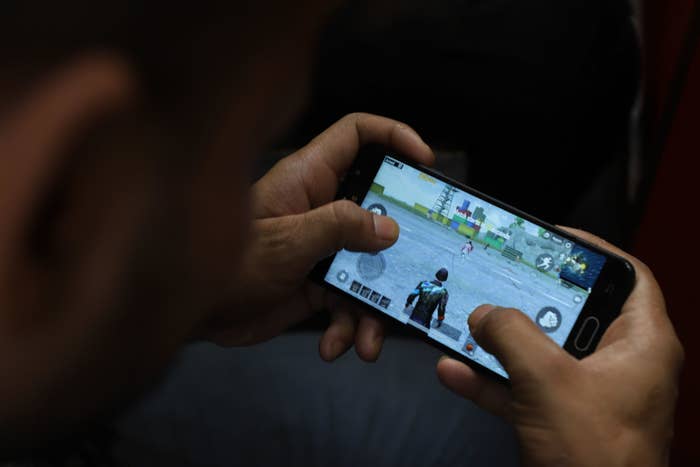
A young boy plays PUBG on his mobile phone at a restaurant in New Delhi on May 3.
Credit by: Nasir Kachroo
Siraj Ansari and his friends — who asked not to be identified for this story — started playing PUBG in mid-2018, shortly after it was released on smartphones. None of them had played video games before, but were hooked to PUBG’s simplicity, its frenetic pace, and the thrill of playing online in real time with hundreds of people across the country. “Sometimes, we simply hang out in the game and use the voice chat feature to talk to people all over India about their lives, politics, the news,” said Ansari.
The premise of PUBG is straightforward: You parachute onto an island along with 99 other online players with no possessions except the clothes your character is wearing. Once you land, you need to scavenge for weapons and other collectibles, and kill everybody else on the island until you’re the last person standing, Hunger Games–style. You can play solo or team up with your mates, and you can talk directly with your teammates or anybody else on the island in real time simply by firing up your microphone. It’s a battle royale style of gaming that has swept the globe for the last two years. According to mobile market research firm Sensor Tower, PUBG Mobile has made$439 million so far. Bluehole, PUBG’s South Korean developer, first released the game on PCs and Microsoft’s Xbox One console in 2017. But it was only in 2018 when Chinese internet giant Tencent published the game as a free-to-play title on smartphones that PUBG exploded in India.
Juhapura, where Ansari and his friends were arrested from, is a poor Muslim neighborhood located four miles outside downtown Ahmedabad. At night, Juhapura comes alive. Hundreds of people throng its markets post dinnertime, buying meat and vegetables and sipping sweet, milky chai from tiny glass cups served by sweaty stall owners in skullcaps. And ever since PUBG swept the country, the ghetto’s youngsters have taken to huddling outside these shops, shooting the breeze, and shooting down players from across the country by forming tight little teams in-game.
When the cop approached him and his friends, they were puzzled, Ansari said. “We didn’t know what was wrong.” They had heard about the PUBG ban in the news — just a day before, police in the city of Rajkot, around 200 miles away, had arrested 10 people for playing it — but hadn’t taken it seriously. “We thought it was one of those freak stories that doesn’t really happen to normal people,” said Ansari.
Video games have always been controversial. Some, such as Grand Theft Auto and Mortal Kombat, have provoked outrage and been banned in multiple countries around the world. But arresting local youth for playing a video game crosses a new line in India.
Ansari had never been inside a police station in his life. Now, shortly after midnight, he was sitting across the desk from two plainclothes police officers who threatened to throw him and three friends pacing nervously behind him in jail. Of the six people Ahmedabad police eventually arrested for playing PUBG, four were Muslims from Juhapura.
For hours, the young men groveled. They’d be better, they said, they’d never do it again. But the cops said they had been keeping an eye on the boys for days and had evidence against them on video. They refused to budge.
The PUBG Corporation, a South Asian subsidiary of PUBG developer Bluehole, declined to comment. Publisher Tencent did not respond to multiple inquiries from BuzzFeed News.

Mayur Cafe in Juhapura, a popular spot where PUBG players gather to play after dark.
A.K. Singh, Ahmedabad’s police commissioner who signed off on the notification to ban the game in the city, told BuzzFeed News that he took the step because playing the game was reportedly “leading to behavioral change and addiction among the city’s youngsters” as complaints poured in from parents that their kids were becoming more aggressive and isolated. Singh said that the city police had also received multiple representations from concerned parents that the game was too addictive. “We endorse our decision [to ban the game],” he said.
“I’m really not sure what behavioral changes the police are talking about,” said one of the three people who were arrested with Ansari from Juhapura. “We play it purely for entertainment. It’s a stress-buster. Sure, it’s true that a lot of school and college kids play it more than it is healthy for them. But surely the police have bigger fish to fry than arresting them?”
Two hours after groveling with the cops, the boys were finally allowed to make a single phone call. Too scared to call their families, they called Younouzbhai Jambhuwalla, the owner of Mayur Cafe, a short, portly man in his late fifties, whom they knew well. Jambhuwalla had seen the two cops in plainclothes taking the boys away, and he’d already been making calls of his own.
After midnight, he called Kaushar Ali, a tall, stocky man in his early forties who has lived in Juhapura for more than two decades. Ali’s part social worker — pushing authorities for better civic facilities — and part political activist — pushing the ghetto’s Muslim minority to get a foothold in the city’s majoritarian politics. Ali’s connections could help the boys stay out of jail for playing a video game, Jambhuwalla hoped.
India, the world’s most populous democracy, has struggled with aspects of technology flooding across its borders. As mobile devices quickly become ubiquitous, parents and educators are raising concerns about online addiction and the game’s risk of spurring violent behavior and distracting young people from their studies. One minister in Goa said PUBG had become a “demon in every house” and demanded that it be restricted. Doctors at a leading digital addiction clinic in Bangalore said they were seeing several people addicted to PUBG each week. Even Narendra Modi, India’s prime minister, seemed clued in. When a concerned mother told him about her son’s mobile gaming addiction at a public meeting in February, Modi immediately replied, “Is that the PUBGone?”
Government responses to perceived online threats have been strong across India at times. There have been more than 300 reported internet shutdowns in the country in the last six years, often in the wake of violent events.
But in particular, Gujarat — a conservative state known for being the home state of Modi, India’s controversial Hindu nationalist prime minister — has been vigilant about curbing the onslaught of not just technology, but all manner of behaviors that officials find offensive (like smearing cake on your friends’ faces at a birthday celebration). It was one of the first in India to block mobile internet in 2014 during a law and order situation, according to the nonprofit Software Freedom and Law Center. Bollywood movies based on a 2002 massacre of Muslims in the state were banned in Gujarat too. And days after India temporarily banned TikTok in April (saying that it exposed minors to pornography), the police commissioner of Rajkot, who arrested 10 people for playing PUBG, requested that Google and Apple remove PUBG from their app stores, saying it was harmful to children (they didn’t).
“I think these bans in Gujarat in particular aren’t really about one particular game or an app,” Ali told BuzzFeed News, sipping a steaming cup of tea at a restaurant late one night in April, not far from where the cops had arrested the four boys. He spoke slowly, drawing out his words. “It’s a way for the state to remind people of its authority every once in a while. It’s a way to show you that if they want to put you in jail for playing a video game, well, they can.”
There are reasons flexing these muscles is easier for authorities in Gujarat, according to Nirjhari Sinha, a human rights activist and the founder of the Jan Sangharsh Manch, a volunteer-led civil rights organization based in the state. After the 2002 Gujarat riots — in which right-wing Hindu nationalists slaughtered hundreds of Muslim men, women, and children in the city over three chilly February days — state authorities have invoked Section 144 of the Indian Penal Code, a Colonial-era law that prohibits four or more people from assembling in a public place together to prevent riots, nearly constantly. It was one of the sections under which several youngsters playing PUBG were charged. “By invoking this section, it’s easy for authorities to pick you up under any flimsy pretext,” Sinha told BuzzFeed News. “You can’t gather in groups, and you can’t protest or hold demonstrations.”
By the middle of March, Gujarat state police had arrested 21 people, most of them college students, for playing PUBG in public. In Ahmedabad and Rajkot, cops in plainclothes patrolled outside college campuses, trendy cafés, and youth hostels, all places where the likelihood of finding young people playing video games on their phones was the highest.
Their strategy was simple, said two police officers involved in the arrests in Ahmedabad who asked not to be named: They swooped down on all groups of boys they saw with their heads buried in smartphones held in landscape mode. More often than not, they struck gold. Some of them were let off with stern warnings. Others had charges slapped against them, were convicted in court, and fined. A 19-year-old college student from Rajkot spent a night in jail before being bailed out the next day.
Singh, the police commissioner, compared the severity of the PUBG arrests to a traffic offense, but to those arrested, the consequences are personal. “I feel tainted by this incident,” one of the boys who was arrested told BuzzFeed News. “My parents were mad I got into trouble with the police when they found out. They’re okay now, but sometimes, my relatives and cousins will still tease me about it and I don’t like that.”
A 20-year-old man who was convicted by the court for playing the game and was eventually let off with a paltry 100 rupees (less than $2) fine, told BuzzFeed News that he was concerned that this conviction was going to remain on his record forever. “I’m about to apply for a passport for the first time in my life,” he said. “What if they deny me one because of this run-in with the cops?”
When BuzzFeed News attempted to contact a 21-year-old in Rajkot about his arrest, his older brother boomed, “Never call my brother again! We’re extremely stigmatized by this incident. Don’t make it worse. Don’t rub salt into our wounds.”
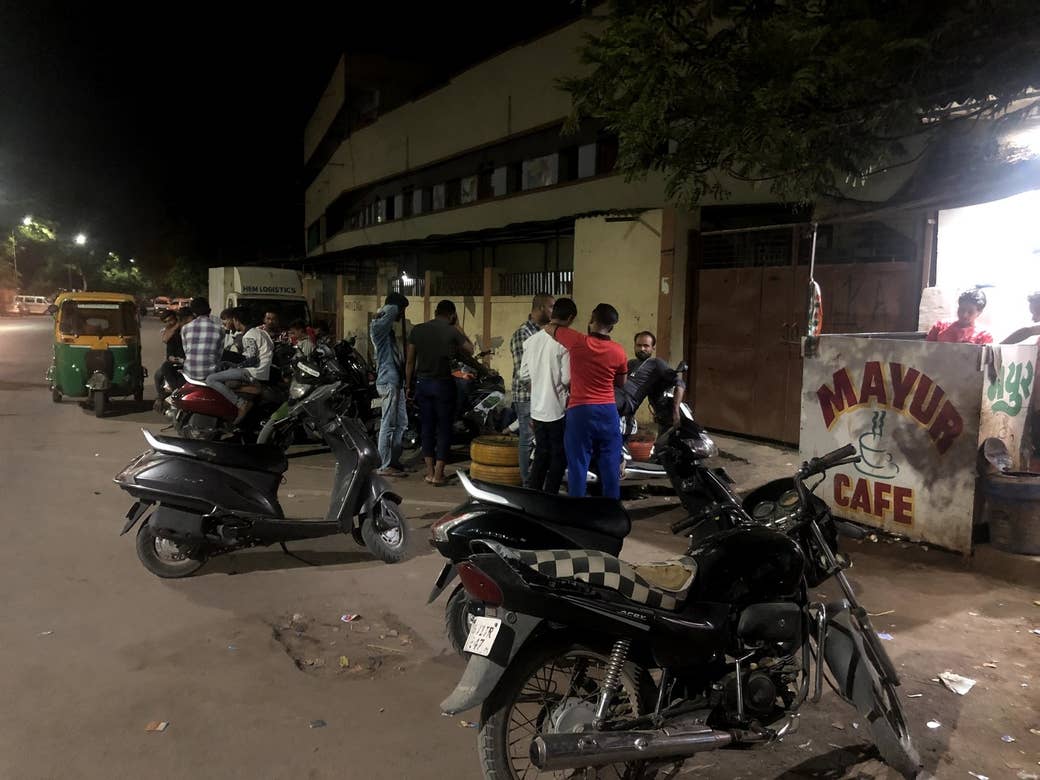
Mayur Cafe in Juhapura.
Credit by: Pranav Dixit
Soon, the debate about PUBG blew up on air on Gujarat’s FM radio stations.
At the Ahmedabad station of Radio Mirchi, India’s largest FM network, Dhvanit Thaker watched the station’s WhatsApp tip line light up with texts and voice messages from listeners. The day Rajkot police arrested 10 people for playing PUBG, the calls started pouring in. Thaker, who is publicly opposed to the ban, listened patiently as upset parents poured their hearts out about their children’s PUBG addiction.
One mother said her 16-year-old son had become aggressive after playing the game for more than 10 hours each day. “Whenever his little sister asks him for something, he hits her,” she wailed. “He never used to do that earlier. I feel helpless.” Another one applauded the ban. “At least now I have something to tell my son to dissuade him from playing,” she said.
Calls from people who played PUBG also poured in: Some were angry at what they saw as a violation of their personal freedom, others boasted that playing PUBG had improved their reflexes and their ability to multitask. “I didn’t tell people on air to not play the game,” he said. “I merely warned them about the impact that it can have on the mind. I’m not into preaching. I’m a friend.”
After receiving an email from an upset mother who wanted help for her 20-year-old son who had become addicted to playing PUBG and smoking cigarettes at the same time, Dhvanit got a psychiatrist on air, who said that although the ban itself was a gimmick, it was high time that India had a debate about the dangers that video games posed.
Meanwhile, reports were flooding in from around the country: In the Indian state of Karnataka, a teenager failed a test after filling his answer sheet with a walk-through of how to play PUBG instead of answering economics questions, saying he was too addicted to the game to prepare for it. In Telangana, a 16-year-old boy reportedly killed himself after his mother scolded him for playing PUBG too much. And in Maharashtra, two men who were hooked on PUBG and were playing it near railway tracks were run over by a train.
“Whenever a game reaches the kind of mass popularity that PUBG has, you’re bound to find extreme cases,” said Daniel Ahmad, senior analyst at Niko Partners, a market research firm that focuses on the Asian gaming industry. “In countries like India that don’t have a tradition of video games, there’s certain a concern from the older generation and anyone who doesn’t really understand gaming about what it’s doing to young people.” Emerging markets like India need to understand issues around gaming and technology addiction thoroughly before resorting to knee-jerk bans, Ahmad said. “That’s not really a solution.”
On March 15, the Ahmedabad City Police released a statement saying that the authorities would work with experts “to provide psychological help and counselling services to rehabilitate victims and wean them away to healthier recreational pursuits.”
Singh told BuzzFeed News that the department already has a couple of counselors on board as part of a victim support system. Concerned parents can approach the police and be connected with these counselors. “We would like to be a catalyst that rakes up societal concerns,” said Singh. “We believe that by banning the game, we did that, and we intend to have more affirmative action in the future.”
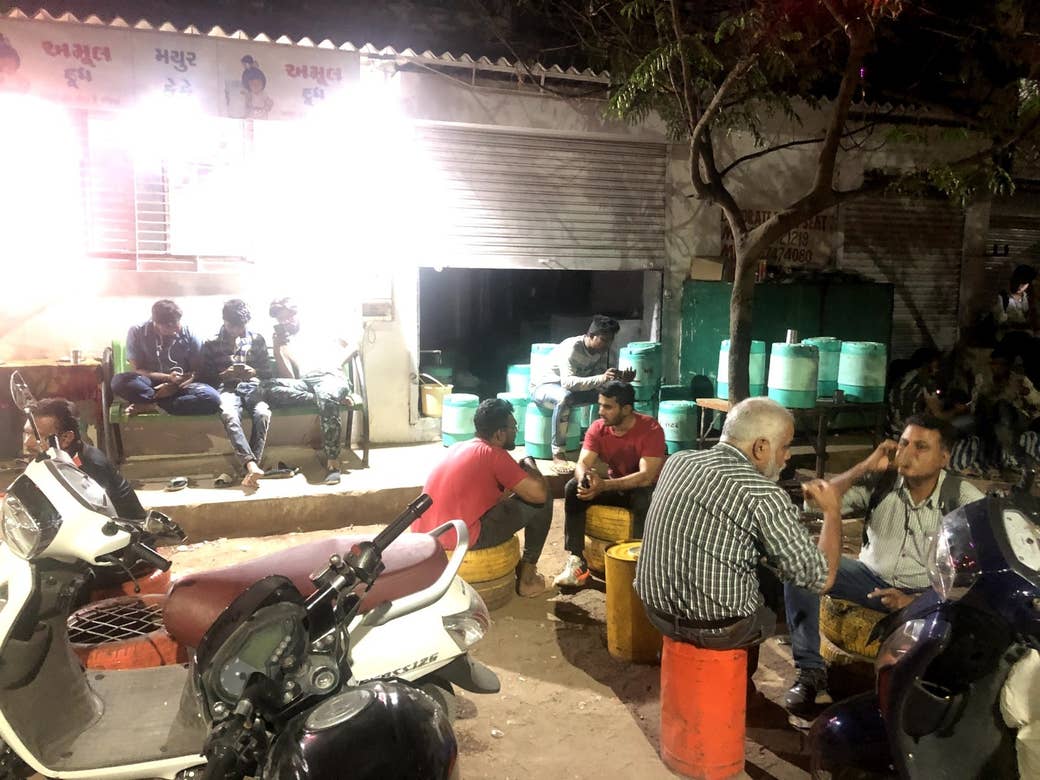
Mayur Cafe in Juhapura.
Credit by: Pranav Dixit
Kaushar Ali and Younouz Jambhuwalla were able to convince the cops to not press charges against Ansari and his three friends after two hours of cajoling. Instead, the group was let go with a stern warning. As they were leaving, one of the cops who had caught them tapped Ansari on the arm. “Look,” he said. “I get that you like the game. Even I play it, but privately. So play in your house. Don’t play it in public.”
Not long after their arrests, the bans on PUBG were lifted in Ahmedabad. By way of justification, authorities said they were calling off the ban since exams in state schools were over and children no longer needed to focus on their studies. In Rajkot and Vadodara, as well as other parts of Gujarat, the ban was called off due to “demand from youth and representations.” Still, it left behind some traces of pain.
Ansari said that he and his friends still play the game, but they’ve cut back on it. “Each time I play the game, I keep thinking about what happened to me,” he said, but there’s anger in his voice. “You know, if the government really wants to stop people from playing this game, why don’t they ban its servers from the country? Why don’t they make it just stop working here? Don’t harass common people like us.”
And yet, some advocates still challenged what they saw as arbitrary restrictions on people’s liberties in court. On April 8, the Internet Freedom Foundation, a New Delhi–based organization, filed a public interest litigation against the PUBG ban in Gujarat. “For a young student who is worried about his family’s reaction and future career prospects, being arrested by the police can be a deeply traumatic experience. To us, the PUBG ban is fuelled by moral panic, and the harms from video games require scientific studies and non-legal methods of engagement,” wrote IFF on its website. The judges threw out the case in about 10 minutes, essentially saying there was no constitutional right to play video games.
IFF Director Apar Gupta told BuzzFeed News that the rate at which new technology is reaching India’s more than a billion people is putting pressure on the country’s constitutional understanding of citizens’ fundamental rights when it comes to the internet. “We need well-articulated regulatory processes,” he said. “We don’t have the breadth of laws required to understand the internet in 2019, and we don’t have an enforcement framework. So bans are a natural course of action for the government.”
“India is dishing out ham-handed solutions without having a clear direction about what its online space should look like,” he said.
Singh, the police commissioner, has a different take. “Everything has two sides,” he said. “If you’re a concerned parent who is seeing your child’s life getting destroyed because they are addicted to this game, you have a different point of view. If you haven’t experienced that, you care more about freedom of speech and freedom of choice. I think it’s important to take a holistic view on this.”
It’s 2 in the morning and the four boys say they need to head home. Even at this hour, the cramped lanes of Juhapura still bustle with activity. Ansari walks for a few yards, reaches a fork in the road, and then turns around. “You know what, go ahead and use my name in your story,” he says. “I’m looking to immigrate to Oman as soon as I can. I’m sick of the government telling me what to do.”
Jimmy Fallon rips into 'Game of Thrones' for the stray water bottle in the finale
Uh oh. Looks like someone left a water bottle under their chair in the Game of Thrones finale.
Jimmy Fallon shared his thoughts on the finale's parting gift to eagle-eyed viewers.
"First the coffee cup, now water, at this point the Iron Throne should just have cup holders," he quipped. "I guess we were just one episode way from being introduced to Lord Dunkin' and Lady Gatorade."
Guess we'll never know.
The internet pays tribute to Grumpy Cat
Content Courtesy of: mashable.com
Written by: Marcus Gilmer

Proving once again that there is nothing good about 2019, the internet woke up Friday morning to the news of Grumpy Cat's passing, the viral pet known for its resting grouch face.
Grumpy Cat's owners announced on Friday on Instagram that the cat passed away on Tuesday at the age of 7. The internet reacted by sharing their condolences and memories of the famous feline, starting with Aubrey Plaza, who starred in the Grumpy Cat movie, as well as Lil BUB and Nala Cat, two of Grumpy Cat's internet famous pet peers.












